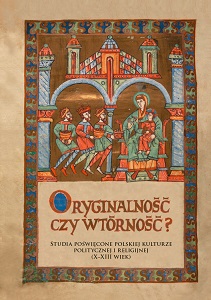Aktywność kulturotwórcza przedstawicielek dynastii w Polsce i w Czechach schyłku XII i pierwszej połowy XIII w. – pierwiastki rodzime i obce
The cultural activity of the female members of the dynasty in Poland and in Bohemia at the end of the 12th and in the fi rst half of the 13th century – native and foreign elements
Author(s): Marzena Matla
Subject(s): Middle Ages, 6th to 12th Centuries, 13th to 14th Centuries, 15th Century
Published by: Wydawnictwa Uniwersytetu Warszawskiego
Keywords: medieval history; church history; Christianity in the Middle Ages; religious culture; Poland during the Piast dynasty
Summary/Abstract: Among the culturally active spouses of the members of the Piast dynasty, two descendants of the Přemyslids: Helen of Znojmo, the wife of Casimir the Just, and Anne of Bohemia, the wife of Henry the Pious, occupy undeniably important positions. Both duchesses on the one hand transplanted onto Polish ground new cultural traditions, especially from their native country, and on the other hand – on their own or together with their spouses – they continued the work of their predecessors. Helen of Znojmo actively participated in her husband’s foundations, and she also supported the development of new religious orders (Norbertine nouns in Zwierzyniec). In addition, she helped in the adoption of architectural and painting models (as indicated by the floor of the Birth of the Blessed Virgin Mary church in Wiślica, and perhaps tetraconch architecture in Zawichost), and also initiated women’s coinage in Polish territories. The activity of Anne of Bohemia was linked to the cultural models propagated on Bohemian ground even to a greater extent. Her foundations not only imitated the activities of her sister, Agnes of Bohemia, the Clarissine, but they also constituted branches of the Prague institutions (Franciscans, Poor Clares, Knights of the Cross with the Red Star); this is where some of the architectural solutions of the newly erected sacred buildings originated from. Her activity was also noticeable in the field of writing. Through the documents that she issued with her own seal she participated in the creation of a new legal culture of Silesia. Probably, the duchess also founded (based on the Prague model) a scriptorium with an illumination workshop in the Poor Clares convent. The activity of both women is also marked by a concern for the memory of the family and the ideology of ducal rule.
- Page Range: 583-653
- Page Count: 71
- Publication Year: 2020
- Language: Czech, Polish
- Content File-PDF

